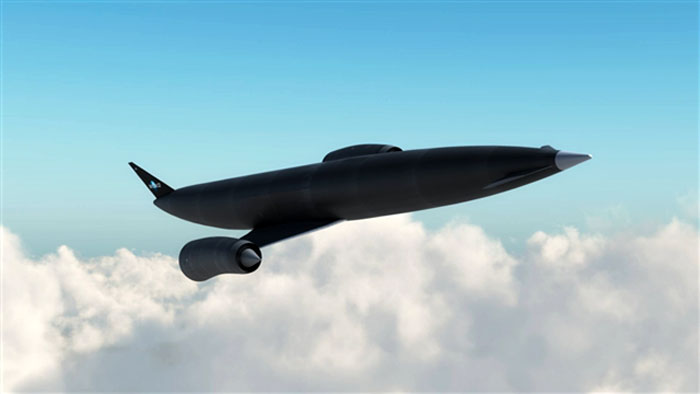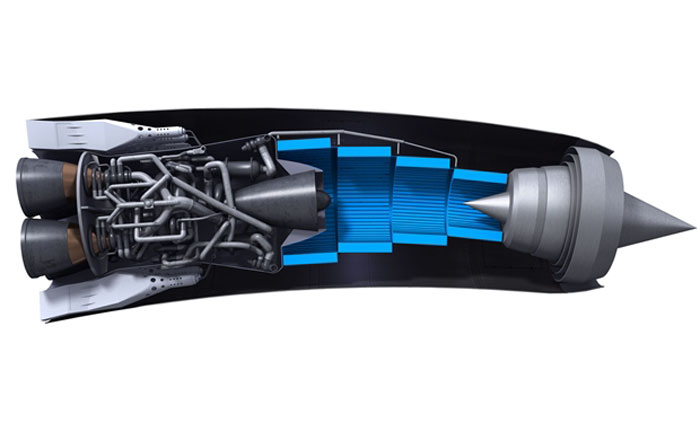-

A revolutionary new air-breathing rocket engine designed to propel a spacecraft to orbit in a single stage has passed a critical milestone. The engine could also revolutionise air travel, reducing journey times around the planet to under 4 hours.
The engine, called SABRE, is a hybrid of a jet engine and a rocket engine. An aircraft fitted with the engines could fly to other side of the planet in under 4 hours travelling at Mach 5.5, more than five times the speed of sound, whilst a spaceplane such as Skylon could be propelled into orbit in a single stage. The engines breathe in air as they pass through the atmosphere, meaning the spaceship wouldn't need to launch laden with a heavy fuel load. However, the challenge of the design has been how to cool the huge amount of air it continuously breathes in without the engine freezing up. The testing has proved that SABRE's pre-cooler heat exchangers can cool air from over 1,000⁰C to minus 150⁰C in less than 1/100th of a second without the engine frosting up.
The UK company which invented the new propulsion technology, Reaction Engines Limited (REL) described the successful testing as "the biggest breakthrough in aerospace propulsion technology since the invention of the jet engine".
REL has also devised a spaceplane called Skylon that would be fitted with the SABRE engines. Skylon would take off and land on runways, and would not require any part of the craft to be jettisoned during its journey to orbit. This would make it a completely reusable spacecraft which could reduce the time and cost of launching payload into space. REL believe the cost of launching satellites could be cut by 90% if the SABRE powered Skylon entered service.
The UK Space Agency asked experts from the European Space Agency (ESA) to validate the pre-cooler heat exchanger test results. ESA experts who reviewed the testing concluded: "The pre-cooler test objectives have all been successfully met and ESA are satisfied that the tests demonstrate the technology required for the SABRE engine development."
The SABRE engine has the potential to revolutionise our lives in the 21st century in the way the jet engine did in the 20th Century. This is the proudest moment of my life
Alan Bond, REL
The engine design is the invention of aerospace genius Alan Bond, who founded Reaction Engines over two decades ago to develop his idea of a hybrid jet/rocket engine. Bond said: "These successful tests represent a fundamental breakthrough in propulsion technology. Reaction Engines' lightweight heat exchangers are going to force a radical re-think of the design of the underlying thermodynamic cycles of aerospace engines. These new cycles will open up completely different operational characteristics such as high Mach cruise and low cost, re-usable space access, as the European Space Agency's validation of Reaction Engines' SABRE engine has confirmed.
"The REL team has been trying to solve this problem for over 30 years and we've finally done it. Innovation doesn't happen overnight. Independent experts have confirmed that the full engine can now be demonstrated. The SABRE engine has the potential to revolutionise our lives in the 21st century in the way the jet engine did in the 20th Century. This is the proudest moment of my life."
-

Illustration of the SABRE engine with the location of the pre-cooler heat exchanger highlighted in blue. Credit: REL/Adrian Mann
Dr Mark Ford, ESA's Head of Propulsion Engineering, said: "One of the major obstacles to developing air-breathing engines for launch vehicles is the development of lightweight high-performance heat exchangers. With this now successfully demonstrated by Reaction Engines Ltd, there are currently no technical reasons why the SABRE engine programme cannot move forward into the next stage of development."
The UK's Space Minister, David Willetts MP, said: "This is a remarkable achievement for a remarkable company. Building on years of unique engineering know-how, Reaction Engines has shown the world that Britain remains at the forefront of technological innovation and can get ahead in the global race. This technology could revolutionise the future of air and space travel."
REL must now raise the funding necessary to take the project to the next phase. Having passed a major technical hurdle the company hopes the decades of research and engineering can now be transformed into a viable economic proposition.
-
Quelle: REL
6906 Views
